Fertilizing Corn Profitability
Good day! I hope all is well!
We received around 2 inches of rain and about 1.5 inches of snow in the past week. The high temperature for the past week ranged from 32 to 72 degrees Fahrenheit with an average of 46 degrees Fahrenheit. That average is 15 degrees lower than the 61 degrees Fahrenheit average we should be having. Another cold week. The temperature forecast for the coming week looks to be below normal again.
Backyard poultry producers please keep up your biosecurity practices! The Highly Pathogenic Avian Influenza (HPAI) is still spreading. It has now been confirmed in 13 backyard and commercial poultry operations in North Dakota with the closest in Barnes County. Keep track of new cases of backyard and commercial operations at the North Dakota Department of Agriculture website: https://www.nd.gov/ndda/node/3694 . In wild birds 162 confirmed cases have been recorded, the most in the United States! The closest county with a wild bird confirmed with HPAI is in Foster County.
Fertilizer prices are very high these days. Urea is costing about $1.00 per pound and 28% Nitrogen is about $1.30 per pound. Hopefully you soil tested last fall or you will try to soil test for nitrogen yet this spring so you know how much is left over from the dry conditions and/or last year’s crop, so you are not spending anymore than you have to for nitrogen fertilizer. As fertilizer prices increase, then a lower rate can usually be applied.
Corn yield is not directly affected by the amount of nitrogen that is applied. Corn yield shows a loss of diminishing return curve with the amount of nitrogen applied. The largest nutrient needed for corn production is nitrogen, so be sure you are not over applying this year.
NDSU Extension has a nitrogen rate calculator at the following website: https://www.ndsu.edu/pubweb/soils/corn/ . This calculator takes into account the previous crop that can supply some nitrogen, which part of the state you are located, what type of tillage has been done in the past, whether there is irrigation, the price of nitrogen per pound, the market price for the corn, the amount of nitrogen in a soil sample from a two foot depth, and the amount of organic matter. Because the price of nitrogen and the price of corn is higher than normal then you must divide both of these prices by two to give you an accurate rate of nitrogen.
The amount of phosphate (P2O5) should be applied based upon an Olsen soil test value. Under normal prices of phosphate an Olsen test value of 0 to 3 parts per million, then 104 pounds per acre of phosphate should be applied. At an Olsen test value of 4 to 7 parts per million apply 78 pounds per acre of phosphate. At an Olsen test value of 8 to 11 parts per million apply 52 pounds per acre of phosphate. At an Olsen test value of 12 to 15 parts per million apply 39 pounds per acre of phosphate. At an Olsen test value greater than 16 parts per million apply 10 pounds per acre phosphate. At the current price of phosphate fertilizer none should be applied broadcast if the Olsen soil test value is higher than eight parts per million. However, a small amount of phosphate needs to be applied to all corn fields at the time of planting whether it is applied to the seed or in a band beside the row.
For the right amount of potassium for corn use the NDSU Corn Potassium calculator which is found at the following website: https://www.ndsu.edu/pubweb/soils/corn_k/ . Information you will need to obtain includes the amount of smectite to illite clay particles, the soil test potassium level, the sale price for corn and the cost of the potassium fertilizer.
This year apply 10 pounds of sulfur as sulfate at planting. Do not apply ammonium thiosulfate over the seed in the row.
Apply a pint or quart of zinc per acre if the soil test value is less than 1 part per million using the DTPA method.
